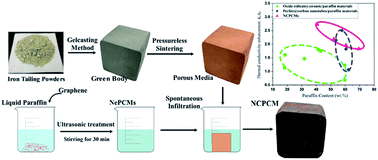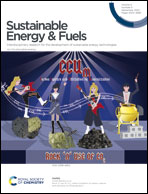Nanoparticle enhanced paraffin and tailing ceramic composite phase change material for thermal energy storage
Abstract
This paper presents the research results of a novel nanoparticle-paraffin-tailing ceramic composite phase change material (NCPCM) for latent heat thermal energy storage applications. The NCPCMs are fabricated by spontaneous melt infiltration of paraffin wax and highly conductive nanoparticles (e.g., nano-graphene) in a porous ceramic framework. The porous ceramic media are made from iron ore tailing (IOT, an industrial waste) with a foam-gel casting method. The micron-sized pores allow the nanoparticles to pass through, with a capillary pressure facilitating fast infiltration during the NCPCM fabrication. The porosity of the ceramic framework can be adjusted for optimal NCPCM properties, including a thermal conductivity of 0.40–0.60 W (m K)−1, approximately twice higher than paraffin wax, and a latent heat up to 121 J g−1. The new composite material also shows excellent mechanical strength, chemical stability, and durability in terms of thermophysical properties. After multiple melting-solidification cycles, the nanoparticles remain in a stable dispersion in the NCPCM, leading to consistently good thermal properties. Experimental results also confirmed easy handling, minimum weight loss and enhanced heat transfer rate for fast charging/discharging in thermal energy storage systems.



 Please wait while we load your content...
Please wait while we load your content...